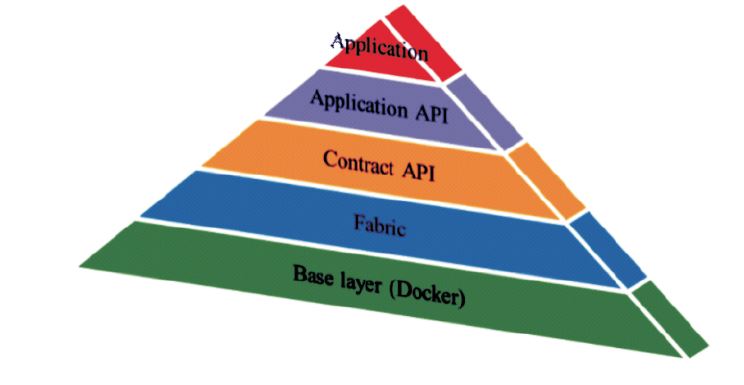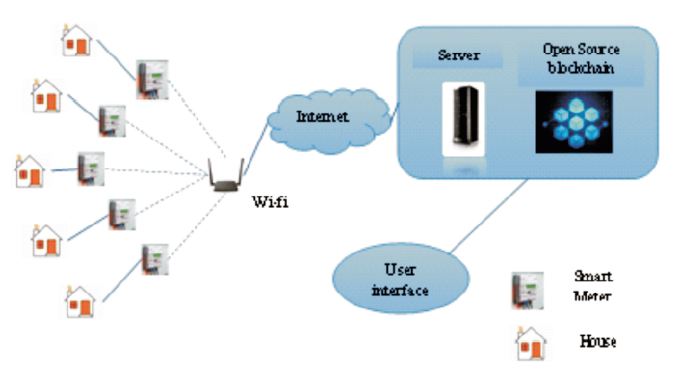
Figure 1. Blockchain Structure
Humans' dependence on electricity is rising with each passing day. The challenge of global warming can be mitigated by using clean energy sources like electricity instead of burning fossil fuels. In order to meet this increased demand, there is a strong need for an effective electricity management system. The use of smart meters for recording electricity consumption data is vital to the idea of a "smart city." Some of the challenges faced in detailing electricity consumption data include saving large amounts of data, deletion, manipulation, and adjustment of data. Blockchain is a promising technology which can address these issues of data integrity and confidentiality using cryptographic algorithms.
Electricity consumption is increasing rapidly on a daily basis (Andrae & Edler, 2015). Due to the increased usage of smart devices at home, in the office, and in industries life is more comfortable and enjoyable (Sloma, 2013). The increase in the usage of portable smart devices like smartphones, smartwatches, and tablet devices is another factor contributing to the overall increase in comfort (Tawalbeh et al., 2016).
However, this increase has led to a rapid change in climate, global warming (Bastida et al., 2019), and higher carbon emissions owing to the increased use of fossil fuels. This in turn has resulted in an increased focus on sustainable development. It is important that the usage of electricity be managed in a manner that has a minimal impact on the environment.
Electricity measurement and monitoring involve detecting thefts in energy consumption. These thefts aim to pay less for overall energy consumption through physical tampering in the case of traditional meters. This tampering does not require higher skills and can be done by a naive lineman. In the case of smart meters, this tampering can be done locally as well as remotely (Jokar et al., 2015),. Tampering with the smart meter requires higher skills and cannot be easily done by an inexperienced lineman. This tampering leads to the meter showing an inaccurate energy consumption value and thus increases the overall energy theft.
Blockchain is a promising technology that can address these issues of data integrity and confidentiality using cryptographic algorithms. It uses a series of blocks containing data in the form of transactions that are linked together using cr yptographic functions. Smart applications using blockchain technologies can be developed using Hyper Ledger Fabric (Hyperledger Foundation, 2022), which is an enterprise-grade distributed ledger framework. Hyper Ledger Fabric is modular in nature and can be used in a wide range of applications. It contains basically an immutable transaction ledger that is maintained by peers in a distributed network. A consensus protocol validates the transactions before placing them in a block. A copy of the block is maintained at each peer node in the network. These blocks are grouped in such a manner that the hash of the previous block is included in the next block, as shown in Figure 1.

Figure 1. Blockchain Structure
Hyper Ledger Fabric consists of five layers, namely the base layer, fabric layer, contract API layer, application API layer, and application layer, as shown in Figure 2. Base Layer is responsible to run the docker software. The fabric layer is used to run the fabric network. A contract API is needed to develop a smart contract. Application APIs are used to develop blockchain applications. The application uses the application API to invoke the smart contract running on the fabric network.

Figure 2. Fabric Application Stack
It is important that issues related to electricity tampering, fraud, and theft (Punmiya & Choe, 2019), it needs to be addressed in order to reduce losses and provide a seamless and uninterrupted electric supply to consumers. Blockchain technology is a new and revolutionary idea that can be used to solve the problems that are caused by the way electricity is used now. The use of blockchain technology along with smart meters will not only eliminate electricity theft and electric meter tampering but will also ensure transparency and build trust among the consumer base that it gets charged only for the service it consumes.
Li et al. (2020) reviewed several existing state-of-the-art anomaly-based detection schemes for the detection of fraud in electricity consumption to find out the challenges with the existing old meters. Based upon these limitations, it proposes a new blockchain-inspired framework that aims to detect anomalies and deviations in electricity consumption accurately and timely using the latest technologies of machine learning, blockchain, sensor processing, and smart meter readings. This framework aims to detect and reduce the losses incurred due to electricity meter tampering, that is quite common. The proposed framework consists of the following phases,
K-Nearest Neighbors (KNN) is used as the main anomaly detection classifier. The working flow of the framework is shown in Figure 3.

Figure 3. Anomaly Detection of Electricity using Blockchain and Machine Learning
Khattak et al. (2020) have used the concept of blockchains, which is a promising technology that can ensure both protection against tampering and complete transparency among consumers and electricity suppliers to address the issues related to electricity theft, and losses by providing complete transparency to consumers about electricity usage. Using the concept of blockchain in smart meters, the problems of storing big data, the removal, manipulation, and updating of data, etc., can be eliminated. The first objective of the study was to automate the process of bidding using smart contracts, keeping in mind the demand and supply of energy consumption, especially in smart cities. The study employed Hyper Ledger Fabric blockchain technology along with composer to provide various security measures like confidentiality and privacy. In addition, the system provided support for dynamic pricing, keeping in mind the demand and supply.
Aiman et al. (2018) developed a peer-to-peer (P2P) token-based billing system for energy distribution using Wattcoin. The study used the Ethereum virtual machine to deploy smart contracts and record transactions. The energy consumed is recorded using smart meters, and the exhaustion contract is used to update the token information in the wattcoin wallet. The token thus updated is transferred to the energy provider account.
Zhang et al. (2019) proposed a double auction system based on consortium blockchain while ensuring the privacy of the transactions with the objective to control the cost and enhance productivity. In order to achieve competitive prices for energy consumption, both the buyers and the sellers are required to bid on the energy price. Proper sorting of the energy prices based on the bid values is being done at both the supplier level and the consumer level. Based on the properly matched value, the supplier sells the energy to the consumer with the matched value.
Pathak et al. (2019) presented a blockchain-based P2P energy management system named BIJLI to sell renewable energy. The angular framework was used to develop the system. The study aims to provide an open and secure system where consumers have the option to choose the kind of energy it requires as per their needs. It focuses on the need for P2P transactions involving renewable solar energy. The study also presented the idea of BijliCoin (BIC) as a reward system for transactions on the BIJLI system. One of the shortcomings of the study is the possible decline in the price of solar energy in the event that there is an increase in the number of producers.
Kulkarni and Kulkarni (2020) discussed in detail the challenges in rural electrification (particularly in India) and the possible solution using blockchain technologies. The unavailability of sufficient and reliable electricity is a grave challenge for the rural population, especially in developing countries like India. This in turn leads to the consumption of other resources like kerosene for daily needs, which has an adverse effect on the environment. This paper discussed the various schemes launched by the government to address this issue and the challenges faced in the execution of such schemes. The study emphasized the need for microgrids and storage systems for the efficient utilization of renewable energy. This would ensure a dependable and adequate energy supply. This paper proposes the use of smart meters based on the blockchain platform to address the issue of irregularities in bills. Various challenges in the adoption of blockchain technologies, like the storage issue, lack of physical connections, regulator y challenges, etc., were discussed.
Jindal et al. (2019) presented a secure demand response system based on blockchain technology named GUARDIAN which aims to address issues in energy trading for household, business, and industrial needs. The system consists of two types of nodes, namely miner nodes and normal nodes. The duty of the miner node is to manage all the energy transactions on the smart grid, including authentication and authorization. Normal nodes usually have smaller ledger sizes as compared to miner nodes. The proposed scheme was evaluated against two public datasets. The results indicated that the proposed system is efficient and can lead to low communication and computation costs.
Table 1 presents the comparison of the various studies on blockchain based energy measurement and monitoring. Ethereum and Hyper Ledger Fabric were found to be the main blockchain technologies used in this paper.
Furthermore, the main objectives of using blockchain were to detect theft and fraud in electricity consumption and provide a platform for fair energy trading among consumers.
Figure 4 presents the proposed architecture of the blockchain-based electricity measurement system. All the consumers' households will be connected to the internet through a smart meter. Electricity consumption data will be stored on the server using an open-source blockchain system. An easy-to-use user interface will be provided to access the consumer's electricity consumption data. Essential attributes of the smart electricity measurement and monitoring system must include the following,

Figure 4. Proposed Architecture
This paper analyzes the existing blockchain-based electricity measurement systems. Blockchain provides an excellent platform to address the challenges of energy consumption. Various studies have shown the potential of using blockchain technologies in smart grids. An extensive comparison of the existing blockchain technologies is presented. Finally, the proposed architecture of an efficient blockchain-based electricity measurement system is presented along with the essential attributes of such a system.
This study was supported by the Jammu and Kashmir Science Technology, and Innovation Council, Department of Science and Technology, and the Government of Jammu & Kashmir.